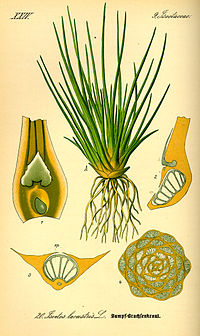
KNOWPIA
WELCOME TO KNOWPIA
Summary
Isoetids are aquatic plants or wetland plants named for their superficial similarity to the quillworts, Isoetes. They occur in wetlands and on shorelines with low nutrient availability.[1] Owing to their slow growth rates, they are also often found in areas with low rates of sediment deposition.[2] Many have evergreen leaves, and CAM photosynthesis.[3] Often they are exposed during periods of low water. Common examples include Lobelia dortmanna and Eriocaulon aquaticum.

Lobelia dortmanna
Eriocaulon aquaticum
References edit
- ^ Keddy, P.A. (2010). Wetland Ecology: Principles and Conservation. Cambridge University Press, Cambridge, UK. p. 26.
- ^ Pearsall, W. H. (1920). The aquatic vegetation of the English Lakes. Journal of Ecology, 8, 163–201.
- ^ Boston, H. L. (1986). A discussion of the adaptation for carbon acquisition in relation to the growth strategy of aquatic isoetids. Aquatic Botany, 26, 259–70.




